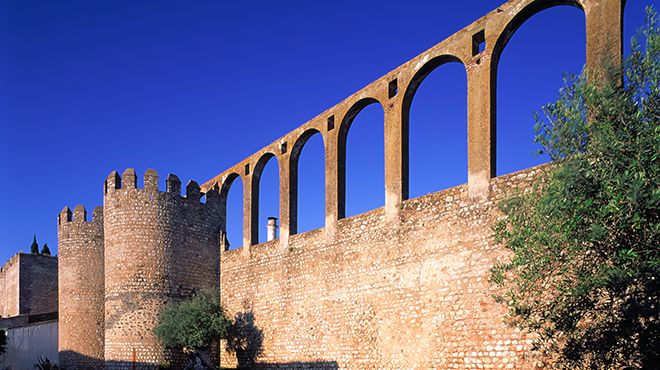Serpa

Serpa
Towns and Villages
Located on higher ground just a few kilometres from the left bank of the Guadiana, the great river that crosses southern Portugal, there is the town of Serpa. The site is known to have been settled since Roman times, around 2,000 years ago.
With the Moorish occupation of the Iberian Peninsula in the 8th century, Serpa was converted to Islam and named Scheberim. Portuguese forces conquered the town in 1166, but it was retaken in 1191 in the major Almohade offensive that reconquered almost all territory to the south of the river Tagus, including Serpa. In 1232, the region returned to Portuguese rule under king Sancho II. During the reign of king Dinis, in 1295, at the time the Luso-Castile border was definitively established, Serpa was granted its first charter. Simultaneously, its imposing, defensive castle was rebuilt and enlarged. In 1707, during the Spanish War of Succession, Serpa was besieged for the final time by Spanish troops led by the Duke of Ossuna.
The first impression of any visitor to Serpa is defined by the grandiose castle walls set off by the Moura and Beja Gates, the only ones remaining of the five original gates. Backing onto the eastern wall, there is the huge count of Ficalho manor house. Also of note is the majestic aqueduct with its Italian arcade extending to the very tip of the southern wall.
Within the town itself the layout of the streets, opening up onto large squares and simultaneously featuring traditional, erudite and religious architectural styles, bestows Serpa with a highly distinctive character enriching any stroll through its ancient streets.
The upper reaches of the town were where the primitive, medieval, Moorish and Christian settlements were concentrated. This is where you can find the church of St. Mary, what remains of the old castle prison tower, the Clock Tower and the Museum of Archaeology. In relation to clocks, there is also the Clock Museum, located in the former Mosteirinho convent, the only one of its kind on the Iberian Peninsula.
Any visit to Serpa must include the S. Gens Pousada. This historic hotel provides unbroken views over a plain broken only by the olive groves of Serpa.
Beyond the town walls, the 15th century St. Anthony Convent is well worth a visit as are the temples devoted to honouring popular saints: Our Lady of Guadalupe and, on the road to Beja, St. Sebastian. The latter is a 16th century construction which wonderfully blends Manueline and Moorish architectural styles, bearing witness to how the two cultures co-existed across the region.
About 10 kilometres to the south, and with the Guadiana river to its left, there is the Guadiana Natural Park. With its rich, natural heritage, the park contains some of the most beautiful landscapes to be found in southern Portugal.
With the Moorish occupation of the Iberian Peninsula in the 8th century, Serpa was converted to Islam and named Scheberim. Portuguese forces conquered the town in 1166, but it was retaken in 1191 in the major Almohade offensive that reconquered almost all territory to the south of the river Tagus, including Serpa. In 1232, the region returned to Portuguese rule under king Sancho II. During the reign of king Dinis, in 1295, at the time the Luso-Castile border was definitively established, Serpa was granted its first charter. Simultaneously, its imposing, defensive castle was rebuilt and enlarged. In 1707, during the Spanish War of Succession, Serpa was besieged for the final time by Spanish troops led by the Duke of Ossuna.
The first impression of any visitor to Serpa is defined by the grandiose castle walls set off by the Moura and Beja Gates, the only ones remaining of the five original gates. Backing onto the eastern wall, there is the huge count of Ficalho manor house. Also of note is the majestic aqueduct with its Italian arcade extending to the very tip of the southern wall.
Within the town itself the layout of the streets, opening up onto large squares and simultaneously featuring traditional, erudite and religious architectural styles, bestows Serpa with a highly distinctive character enriching any stroll through its ancient streets.
The upper reaches of the town were where the primitive, medieval, Moorish and Christian settlements were concentrated. This is where you can find the church of St. Mary, what remains of the old castle prison tower, the Clock Tower and the Museum of Archaeology. In relation to clocks, there is also the Clock Museum, located in the former Mosteirinho convent, the only one of its kind on the Iberian Peninsula.
Any visit to Serpa must include the S. Gens Pousada. This historic hotel provides unbroken views over a plain broken only by the olive groves of Serpa.
Beyond the town walls, the 15th century St. Anthony Convent is well worth a visit as are the temples devoted to honouring popular saints: Our Lady of Guadalupe and, on the road to Beja, St. Sebastian. The latter is a 16th century construction which wonderfully blends Manueline and Moorish architectural styles, bearing witness to how the two cultures co-existed across the region.
About 10 kilometres to the south, and with the Guadiana river to its left, there is the Guadiana Natural Park. With its rich, natural heritage, the park contains some of the most beautiful landscapes to be found in southern Portugal.




 Explore
Explore 
 Remember and Share
Remember and Share 


